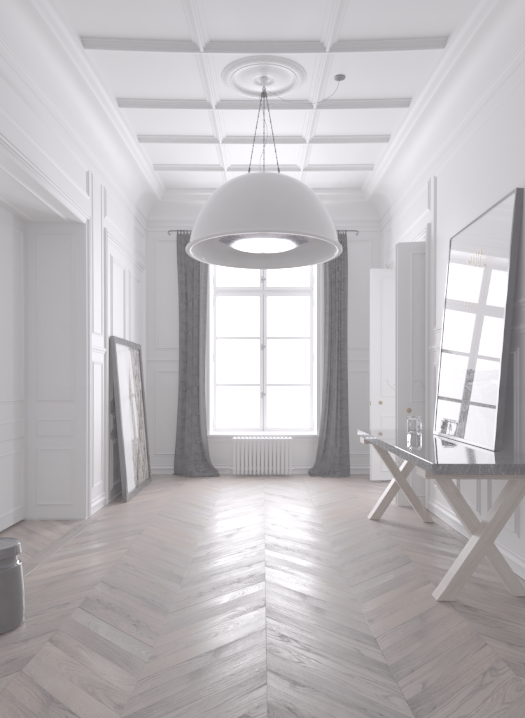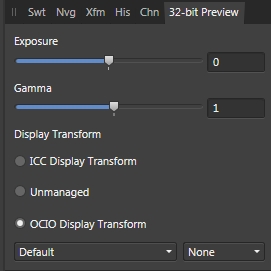-
Posts
20 -
Joined
-
Last visited
Posts posted by Mareck
-
-
All is in the title, OPS from (ASC-CDL) is a nice color grading tool to work on linear image (in fact any image).
The formula is: Out= (i*s+o)^p
Where i is input, s is slope, o is offset, p is power.
The node in Blender:
[Edit]
Since the Topic has moved to feature request, I think it deserve some more infos.
Offset is how bright or dark (+ color) the lowest values (shadows) are
Power is the contrast + color
Slope is how bright (+ color) the highest value (highlights) areThis tool is a unified cross software tool which means if you put same values in differents software you'll see the same result.
Really a must have tool.
If people are interested I can add a vidéo of how it works. -
@troy_s Like James said in the other thread, it wasn't planned for exporting to 8/16bit format, what surpise me but it explain why it don't works.
Do you think it's feasible to create a neutral ICC profil (no transfer curve and no color convertion)?
If so I could learn to make one and add it to affinity, that way I can choose it at export time and the problem is solved. -
Ok I understand, I was trying to do something that wasn't created for that, but it's a pity.
I know that from a user point of view things look more simple that they are, but I think providing a neutral ICC profil wouldn't be too hard.
I'll try to learn if it's possible to do one.
Thanks -
@troy_s I'll post a screenshot for the red shift and I'll try what you said, and thanks for the precisions on linear sRGB.
@James Ritson thanks for the time you spend on that answer.
I try to set a workflow to magnify render for 8bits export but I'm definatly interessed in editing and export to an other app since I can be brought to make render for comecial video ad.
Yes I've change settings to try things and moving forward, my workflow to beautify renders is:
Import linear .exr, convert from linear to Log space with OCIO, then adding a creative LUT wich already convert from Log space to sRGB one, therefore I don't need an additional transform with ICC. I'm working in unmanaged preview since I only want the transforms I choose in my stack and the end of my stack is already in sRGB space with the LUT.
But I'll definitely try what you explained, there is a lot of usefull info, but it's a bit late here, I'll let you know how it went. -
Thanks @GabrielM but do you think an option to disable ICC at export is feasible? Or having a neutral (no transfer curve) ICC profile?
It's a pity that such a nice workflow (OCIO layer adjustment) is "broken" at the export step. But I need to try James Ritson answer on the other tread to see if there is an alternative.
Thanks @walt.farrell I'll add a .afphoto tomorow (it's late here).
You're right when saying:6 hours ago, walt.farrell said:As long as you choose "Use Document Profile" I wouldn't expect any further conversion to be done, and I would expect the file to be exported as shown on-screen.
IF your preview is set to ICC display Transform, you see the exact result but a transfer curve is apply on top of your stack, what I don't want.
I set my preview to unmanaged so I see exactly what my stack is doing (not the scene linear part, I know), I only want the transformations I choose since my creative LUT already convert from a Log profil to a sRGB one. -
Thanks to try @GabrielM but it doesn't work since ICC profile just above is set. And there isn't an option to say no ICC profile.
Don't know what the embed is for but I assume it's just informations.
Edit: or perhaps the option has a bug when you uncheck embed ICC -
Quite everything is in the title, but to be more contextual, I'm working with 32bits linear .exr (3D renders).
To have a proper non destructive workflow I use OCIO layers to convert from linear space to color profil spaces, then I use creative LUT (or do manual adjustments).
Exemple: OCIO layer to convert from scene linear to Slog, then a creative Log LUT to have my look, and export to final 8bits format.
The problem is at the end of the process, when exporting an image there is an ICC profile apply on top of my stack, so it add an aditionnal transfer curve wich altered my work.
I don't talk about how to view my work how it's exported, I know that, but I want my work not to be altered with additionnal transform.
I know a cheap way of doing what I want but it's not satisfying.
So, is there a way of disabling ICC profile during the export? Or is it planned to add the option in a future release? -
39 minutes ago, dkj said:
I'd love to see a tutorial about using Affinity Photo to mimic different types of vintage colour film.
Look about LUT's, color grading, and raw topics.
And in case you're not aware of, there is a great tutorial section in the forum, with lot of subject. -
I haven't found a way to disable ICC at export time for the moment, I'll make a post about that.
I'm not sure to understand well, I've tried scene linear to linear sRGB, slight shift of the red channel (because my image is mostly red dominant) and looks like there is a compression of the values to 0/1 range.
And scene linear to linear sRGB then linear sRGB to output sRGB, no difference at all between scene linear to output sRGB.
What I don't understand is what's linear sRGB for? I mean in general use. -
-
2 hours ago, troy_s said:
Are those all of the places where ICCs are integrated in Affinity?
I'm not sure but I think yes. In fact I haven't found so much about ICC in affinity in the officials doc and tutorials.
I tried with linear sRGB but it's not a close 1/1 export compare to sRGB view.
3 hours ago, troy_s said:That looks suspiciously like the sRGB OETF is being applied on top of the output stack.
You're right, the best I can have is by having an EOTF curve on top of my stack to counter the OETF's one from the ICC.
So now I can work with 32 bit linear exr, but it looks a bit like a hack^^.
So it answer my question, doesn't look like the 32 bit linear workflow is so well implemented here. -
Thanks to both of you, I wouldn't thought I'll fall in the rabbit hole again ^^
For The scene linear values I think Troy is talking about the renderer engin values wich haven't any 0 to 1 limit and Frank is talking about exported Exr linear values wich are 0 to 1 in floating point, am I right?
12 hours ago, Frank Jonen said:I'd wish Affinity had a checkbox to turn off ICC profiles for 32-bit spaces and leave us in a pure OCIO workflow and a clearer information of how an imported EXR was 'converted' to scene linear. The ICC toggle would need like two confirmation dialogues the first time it is set. "Are you sure? This will look horrible on non-hardware calibrated devices." and "Yes, my body is ready."
Personally I think it'd be fantastic to have Serif as an ACES partner and the Affinity suite have an official "ACES mode" where everything just works and an option to screw it up manually.
I agree with that, even if I've read that ACEScg have problems with self reflecting colored materials (if I'm right)
12 hours ago, Frank Jonen said:Gamma is still an issue in Affinity as you might have noticed the hard way. For some inexplicable reason the sliders end at 0 and 2. Maybe that is useful to someone out there. If anybody finds that necessary, fine. But Affinity really needs a sensible Gamma transform. The current one in the Levels layer is just terrible. It sounds like that adjustment layer might eventually be replaced by a good one though in the future from reading the roadmap.
Yes, completely nonsense here.
8 hours ago, troy_s said:To start, disable any ICCs in your chain, as well as any power functions (Awful term "gamma"). Apply the same OCIO transforms on your image as you were doing in the other application.
Do you see 1:1? If so, does the exported display referred format appear 1:1?
I think it's the point here, I haven't found a way of disabling ICC at the export time. (I think it's when converting from 32bit to 8bit)
I've set my display transform to unmanaged, this way I see exactly what the stack is doing.
I've got EXR 32bit linear, followed by a OCIO layer linear to log, then OCIO log to sRGB but the export is washed out because of ICC export transformation, it's why I need to compensate with an S curve shape before the export.
(exported image without S curve)
-
I explain myself,
After 2 days of trials, watching tutos, topics on the forum, I finally managed to have a fonctional 32bits linear workflow in place.
I've tried tones of LUTs, OCIO layer and 32bits preview configs but, the better I had was a good viewing and a crap export.
Finally I've found a way, perhaps not a good one, but a way.
I've read @Frank Jonen talking about a gamma issue on a spécific question so I've tried the transfer fonction trail.
It lead me to add an S curve shape on top of my layer stack and this time my LUT worked as expcted and the export too.
But why do I need to do something approximative to have all working?Infos:
-working with 32bits EXR float (full) linear render
-OCIO layer to convert from linear to LOG
-LUT layer to apply a creative Log base look
-S curve shape on top
-ICC or OCIO 32bit preview
@troy_s welcome to the discussion
-
Thanks Troy,
Nice to see you there, I'm struggling since 2 days to have a fonctionnal 32bits linear workflow in AP.
I've managed it but not the optimal way I think.
I'm making a new post for that, you'll be welcome there^^ (I'll mention you so you know when it's done) -
-
Ok thanks, now I'm ok with OCIO layers.
I've watched the videos on Affinity channel, great help too.
Still not completly sure when to use OCIO layer instead of LUT layer.
-
Thanks @GabrielM
I wasn't sure to understand your purpose, but now I think it's ok, you aren't advising to export in sRGB but to work linear and visualise in sRGB.
I've investigated a bit more about how it works in Affinity and now I'm ok with the 32 bits workflow, but one thing I'm not completely sure is, the workflow for OCIO layers.
Is it 32bits preview in ICC, then OCIO layer source to sRGB and destination to what's needed?
Because it's nice to have the possibilitie to mask the OCIO layer or to have it just on a spécific layer.
And thanks one more time @James Ritson -
Thanks James, we are getting forward,effectively I'm in OCIO display Transform, and when I set the display transform to ICC it's what I have when I'm exporting.
But not what I want ^^.
My workflow is:
Rendering in Blender, export in linear 32bits .EXR to keep information for gradding.
Import in Affinity photo with the Filmic sRGB OCIO from Blender.
I do like this because in Blender I have the Filmic OCIO view directly in the previw (specific Log view), so I work with this view for lighting and shading.
But even if we have color gradding and post prod tools in Blender, doing it in Affinity is more effective and flexible.
So do you tell me there isn't a way to export what I have on screen with OCIO display transform? Or I'm doing something wrong?
I'm a neeby with Affinity photo.
PS: sorry I forgot the screenshot, I feel I know what you'll told me, my view is on none, so no way of exporting what I see isn't it? ^^ -
Hi there,
I've got a problem exporting a CG render.
The source is an .EXR 32bits linear, I've applied an OCIO, LUT... everything is correct in affinity (right contrast) but when I export it, it looks like there something wrong with the color profil (not sure).
The image looks dull.
i've tried different export format, color profil but always the same problem.
I'm on windows with Affinity Photo 1.6.4.104











Feature request: ASC-CDL Offset Power Slope in Photo
in Feedback for Affinity Photo V1 on Desktop
Posted
Ok thanks